Types of Clouds: Do you enjoy seeing the clouds? Do you appreciate the various patterns of gorgeous clouds in the sky? Then you must be eager to learn about the various types of clouds. A cloud is a collection of ice crystals and small water droplets floating in the Earth’s atmosphere. All types of Clouds are incredibly dense and massive masses that appear to the bare eye. Clouds are named differently depending on their shape and height in the sky. Some clouds are puffy and fluffy, like cotton, while some are grey and homogeneous. Some clouds are close to the ground, while others lie near the tropopause. Continue reading this article to learn how to identify many types of clouds and what kind of weather to expect from each cloud.
Types of Clouds
Since clouds are the luminous objects in the visible area of the sun spectrum, all types of Clouds serve a number of purposes in the climate system, including cooling the planet by effectively reflecting light into space. Clouds come in a variety of sizes and shapes. There are about 100 different varieties of clouds, according to the World Meteorological Organization’s International Cloud Atlas. The numerous variations, on the other hand, can be classified into one of 10 fundamental kinds based on their general shape and height in the sky. Clouds’ size, shape, or colour distinguishes them from one another.
Types of Clouds UPSC
Most clouds are classified as high, middle, or low depending on the height of the cloud’s base over the Earth’s surface. Other clouds are classified based on their distinct properties, such as those that originate above mountains (lenticular clouds) or lie beneath existing clouds (Mammatus clouds). Different types of clouds arise at different heights in polar, tropical, and other locations. The table below describes cloud classification and related cloud kinds. The figure depicts the location of several types of clouds in the sky.
| Classification of Types of Clouds | ||
| Position | Hight |
Types of Clouds
|
|
Low-level Clouds
|
less than 6,500 feet (1,981 m) in elevation | Strato Cumulus/ Stratocumulus |
| Stratus | ||
| cumulus | ||
|
Middle Clouds
|
between 6,500 and 20,000 feet (1981-6,096 m) | Altostratus |
| Nimbostratus | ||
| Altocumulus | ||
|
High-Level Clouds
|
above 20,000 feet (6,096 m) | Cirrus |
| Cirrostratus | ||
| Cirrocumulus | ||
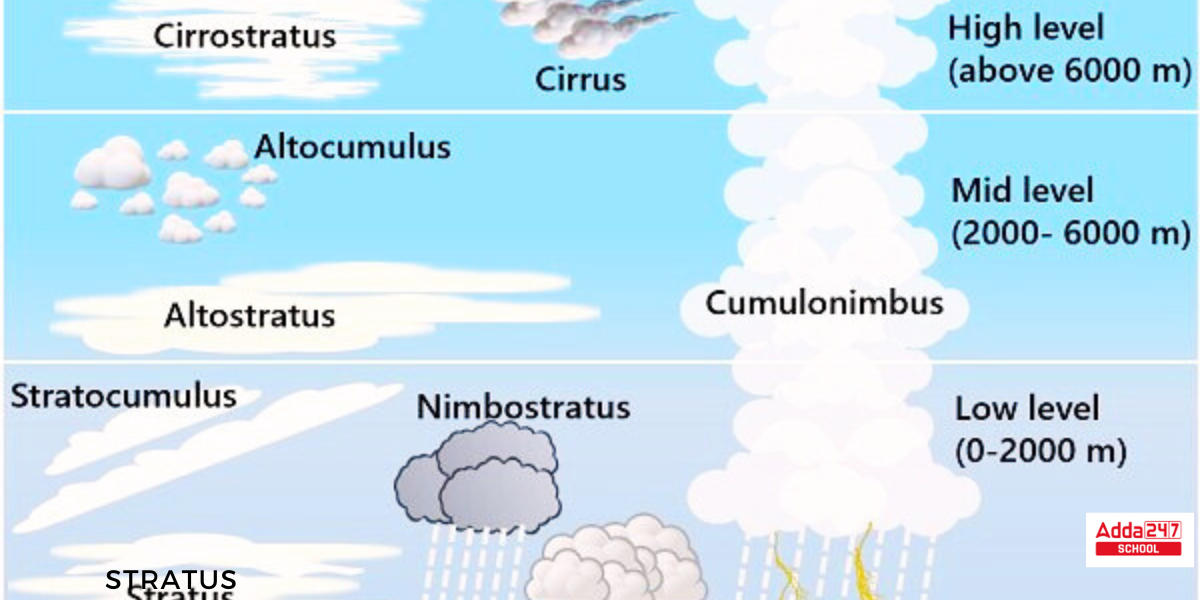
Types of Clouds and Their Characteristics
Clouds come in various types, each with its unique characteristics. Clouds are classified into four primary cloud genera, which are then further subdivided into species and varieties. Here are the main cloud genera and some of their characteristics:
- Cirrus Clouds (Ci):
- High-altitude clouds found at altitudes of 20,000 to 40,000 feet (6,000 to 12,000 meters).
- Composed of ice crystals.
- Thin and wispy appearance.
- Often indicate fair weather but can precede a change in weather.
- Cumulus Clouds (Cu):
- Typically seen at various altitudes.
- Have a puffy, cotton-like appearance.
- Associated with fair weather when small but can develop into thunderheads (cumulonimbus) during atmospheric instability.
- Stratus Clouds (St):
- Low to middle-altitude clouds.
- Cover the sky like a blanket, often gray or white.
- Can bring overcast or drizzly conditions but usually not severe weather.
- Nimbus Clouds (Ns):
- Clouds associated with precipitation.
- Often combined with other cloud genera.
- “Nimbus” is added to the name of the primary cloud type when it’s producing rain or other forms of precipitation.
These primary genera can further be classified into species and varieties. For example:
- Cumulonimbus Clouds (Cb):
- A variety of cumulus clouds.
- Towering and have an anvil-shaped top.
- Associated with thunderstorms, heavy rain, lightning, and sometimes severe weather.
- Cirrostratus Clouds (Cs):
- A variety of cirrus clouds.
- Appear as a thin, high veil covering the sky.
- May signal the approach of a warm front.
- Stratocumulus Clouds (Sc):
- A combination of stratus and cumulus.
- Appear as low, lumpy cloud layers.
- Often seen in stable weather conditions.
These are just a few examples, and there are many more cloud species and varieties. Understanding cloud types can help in predicting weather patterns and making weather-related observations.
How do Different Types of Clouds Form?
- Water vapour can seem undetectable, but it is constantly there in some quantity in the sky. Clouds form in the sky from the water. Clouds form when the air becomes entirely saturated with water vapour. Water may evaporate from the earth or migrate from other locations.
- Clouds arise when a region of air cools to the point where water vapour condenses to liquid. Water will condense in the presence of dust, ice, or sea salt. Warm air holds more water vapour than cold air.
- Clouds occur when the air is slowly chilled and is formed of damp air. The water vapour and ice particles within the clouds get larger as the air cools further, and they fall to the earth as rain, drizzling snow, sleet or hail.
Types of Clouds Images with Names
The air in which clouds develop must be chilly enough for the water vapour to condense. The temperature, wind, and other environmental factors all have a role in determining what form of cloud it will be.
As previously observed, clouds can be roughly categorised depending on the heights of three categories of clouds. Each of the 10 types of Clouds and their characteristics are covered in depth below.
First Types of Clouds: Stratocumulus
On usually cloudy days, stratocumulus can be seen. These patches of low, puffy, white, grey, or gray-green clouds can be seen in the sky between them. Stratocumulus would form when one took an imaginary blade and sliced cumulus clouds evenly across the sky but not into a smooth layer like stratus. Stratocumulus has a black, honeycomb look when viewed from below. When there is weak convection in the atmosphere, these types of clouds form.
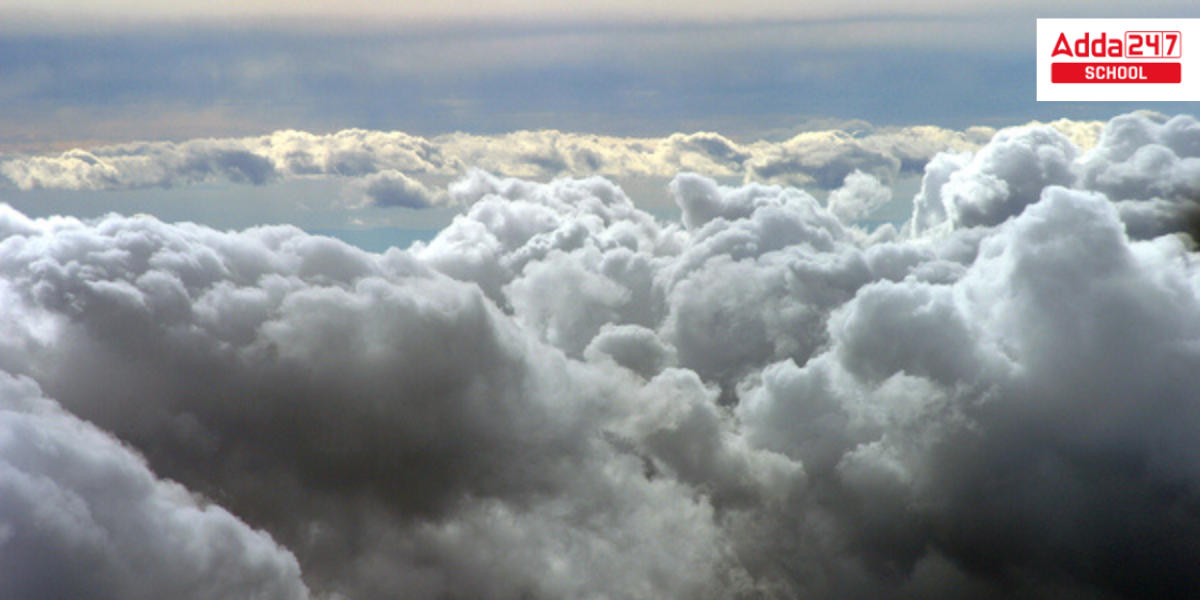
Second Types of Clouds: Stratus
A stratus cloud predicts a cloudy, cold day. Stratus clouds are a flat, featureless, homogeneous layer of greyish cloud that hangs low in the sky. It usually results in drizzle, ice prisms, or snow grains. When the light shines through this cloud, the outline of the sun is clearly evident. These clouds resemble fog that follows the horizon (rather than the ground). The blue sky is frequently visible as a layer of stratus breaks up and disappears. On gloomy days, stratus clouds appear and are connected with mild mist or drizzle.
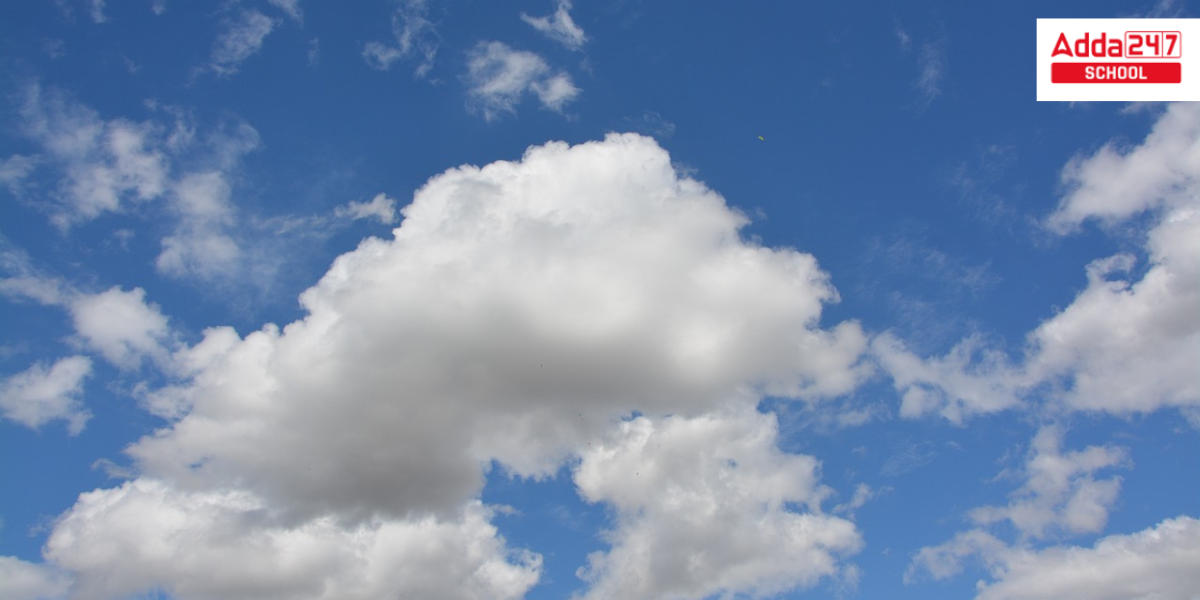
Third Types of Clouds: Cumulus
Cumulus clouds form on bright, sunny days when the sun directly heats the ground below. These look to be made of cotton wool. They are spread throughout the area and can be found in patches. Cumulus clouds are the clouds that you learned to sketch as a child and serve as the symbol for all clouds. These clouds’ sunny sections are predominantly bright white, but their bases are fairly dark and horizontal. They are known as “fair weather” clouds. They appear late in the morning, grow, and eventually fade away towards nightfall.

Forth Types of Clouds: Altostratus
Altostratus typically develops ahead of a warm or foggy front. At mid-levels, Altostratus appears as grey or bluish-grey cloud sheets that partially or completely cover the sky. They are translucent enough to reveal the sun through the ground glass on a regular basis. When there are altostratus clouds, neither the halo effect nor ground shadows are visible. Even though they block out the sun, you can usually see it as a softly illuminated disc behind them, but not sufficient light to cast shadows on the ground.
They can also coexist with cumulus during a cold front.
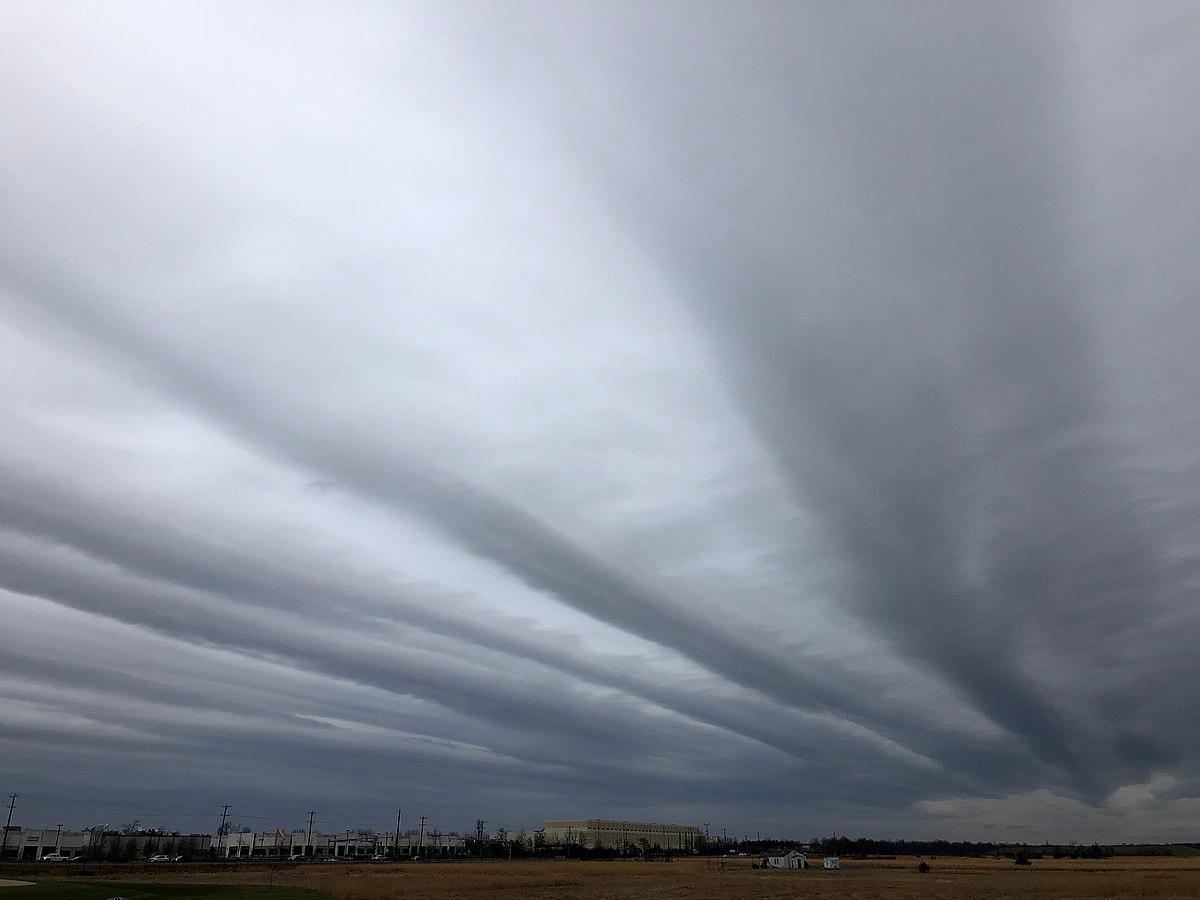
Fifth Types of Clouds: Nimbostratus
Nimbostratus is the constant rain cloud. Because of the rain or snow that is pouring, this layer of dark grey clouds is less intense. They can form in the lower and middle levels of the atmosphere and are dense enough to obscure the sun. Altostratus thickening causes it. It is constantly thick enough to keep the sun out. The cloud base lowers into the low level of clouds as the precipitation continues. This cloud appears anytime there is persistent rain or snow falling (or is projected to fall) over a large area.
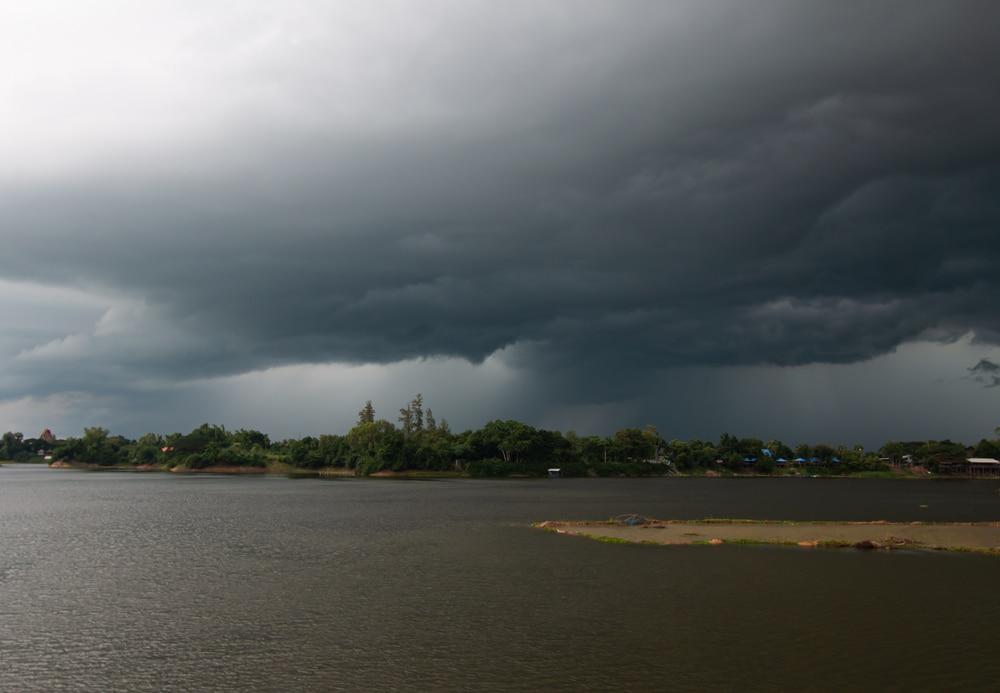
Sixth Types of Clouds: Altocumulus
Altocumulus is frequently seen on humid and warm mornings, especially during the summer. The most prevalent components of white and/or grey patches, sheets, or multilayered clouds are laminae (plates), spherical masses, or rolls. They could be extensive or fibrous in nature. They resemble sheep wool or mackerel fish scales, earning them nicknames such as “sheep backs” and “mackerel skies.” When a border or a thin, partially transparent patch of altocumulus crosses in front of the sun or moon, it creates a corona.

Seventh Types of Clouds: Cirrus
Cirrus clouds are more common in clear weather. Cirrus clouds are thin, white, wispy threads of clouds which move across the sky, The name Cirrus implies in Latin – “curl of hair”. Cirrus clouds are made up of microscopic ice crystals instead of water droplets because they appear above 20,000 feet (6,096 m)—an height with cold temperatures and low water vapour. Because these clouds can build ahead of fronts of warmth and large-scale storms like nor’easters and tropical cyclones, viewing them can also warn that storms are on their way.
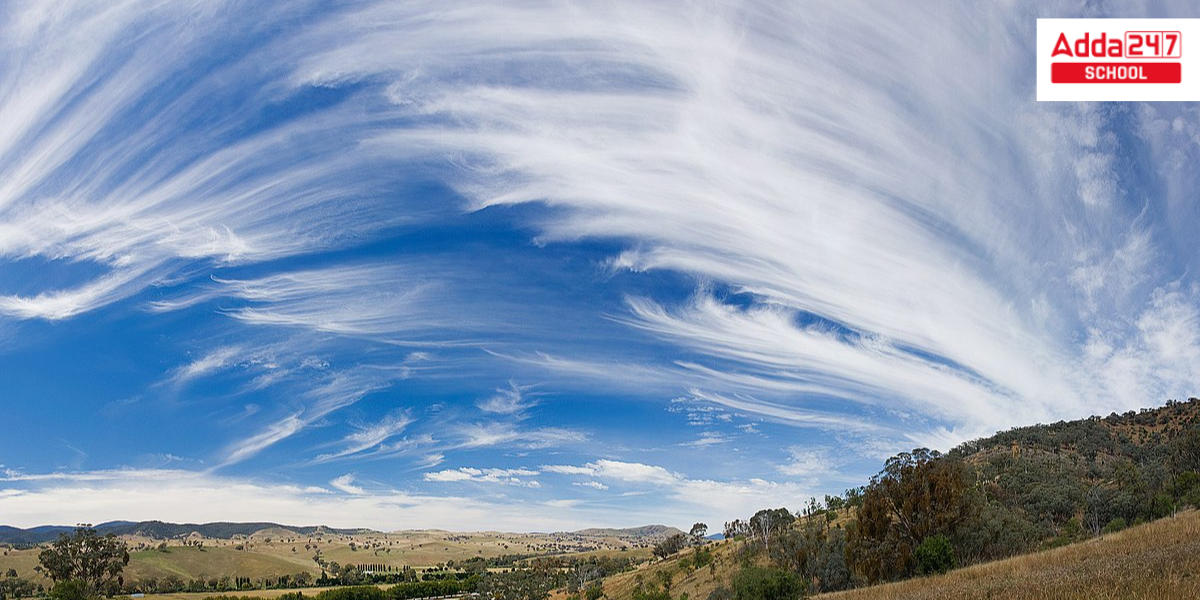
Eighth Types of Clouds: Cirrostratus
Cirrostratus Clouds are transparent, whitish veils that are shiny or that appear fibrous (hair-like). Cirrostratus implies that there is a lot of moisture in the high atmosphere. Looking for a “halo” (a ring or circle of light) surrounding the sun or moon is a dead giveaway for cirrostratus. The halo is generated by light refraction on ice crystals in the clouds, similar to how sundogs form, but in a whole circle rather than simply on each side of the sun. A massive sheet of cirrostratus almost always ends up engulfing the entire sky.

Ninth Types of Clouds: Cirrocumulus
Cirrocumulus clouds are little patches of ice crystal clouds that dwell at high altitudes and are commonly grouped in rows. The cloud is all white. They are composed of extremely small particles that resemble regularly spread grains or waves. The individual cloud mounds of cirrocumulus, known as “cloudlets,” are significantly smaller than those of altocumulus and stratocumulus and often resemble grains.
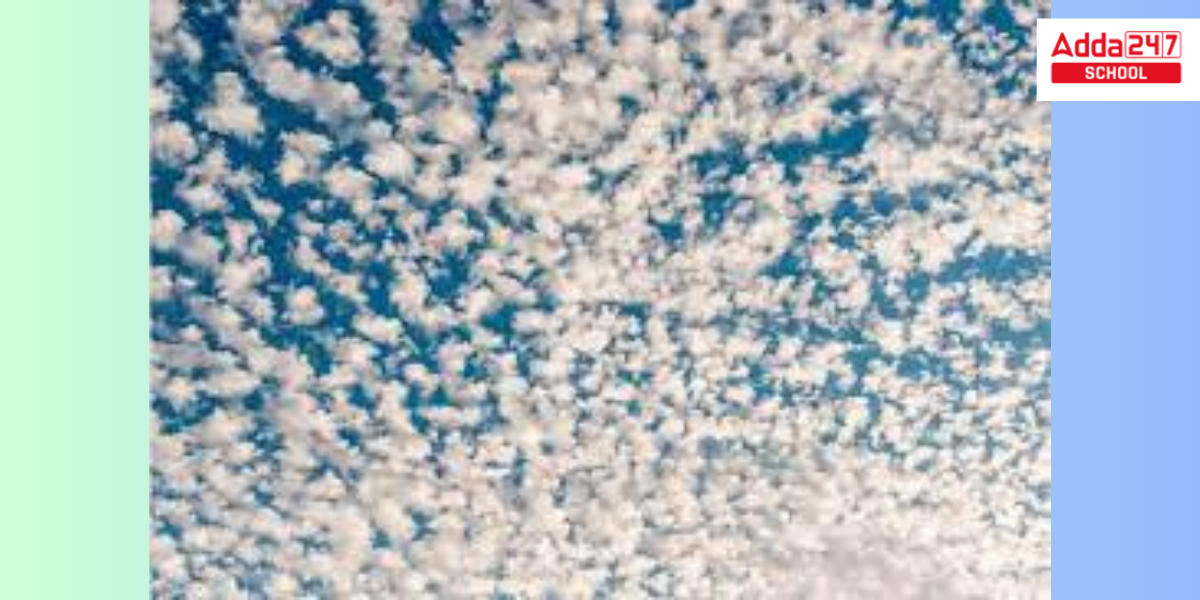
| Related posts | |
| Types of Angles | Types of Triangles |
| Types of Motion | Types of Bank |
| Types of Fever | |
| Types of Teeth | |

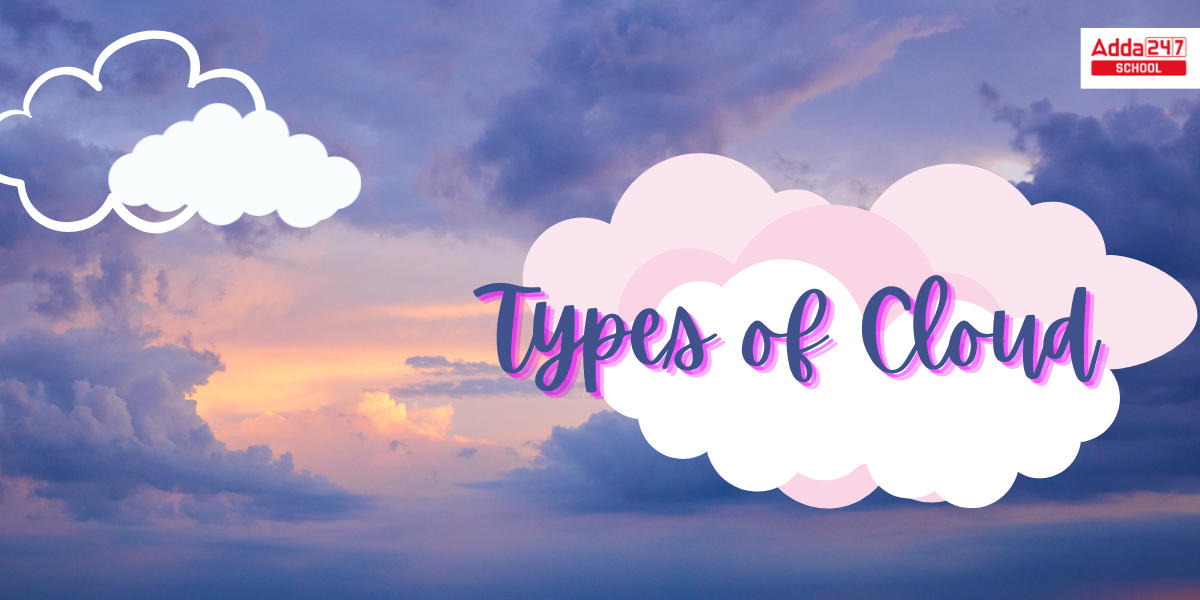







 MGSU Result 2025 Out, Download Maharaja ...
MGSU Result 2025 Out, Download Maharaja ...
 EMS Results 2025 OUT at gnanasangama.kar...
EMS Results 2025 OUT at gnanasangama.kar...
 How to Calculate CUET Score, Check Marks...
How to Calculate CUET Score, Check Marks...









